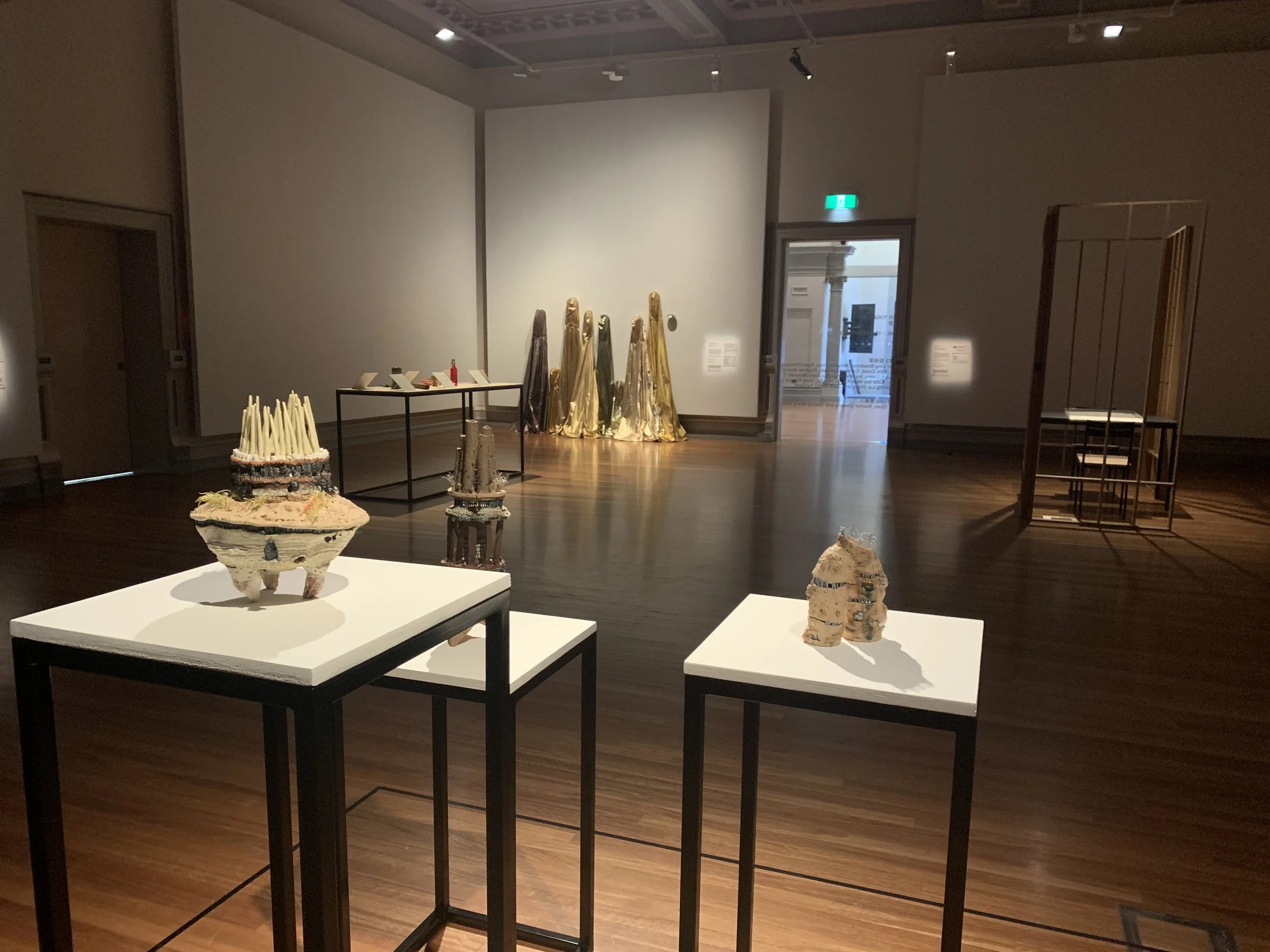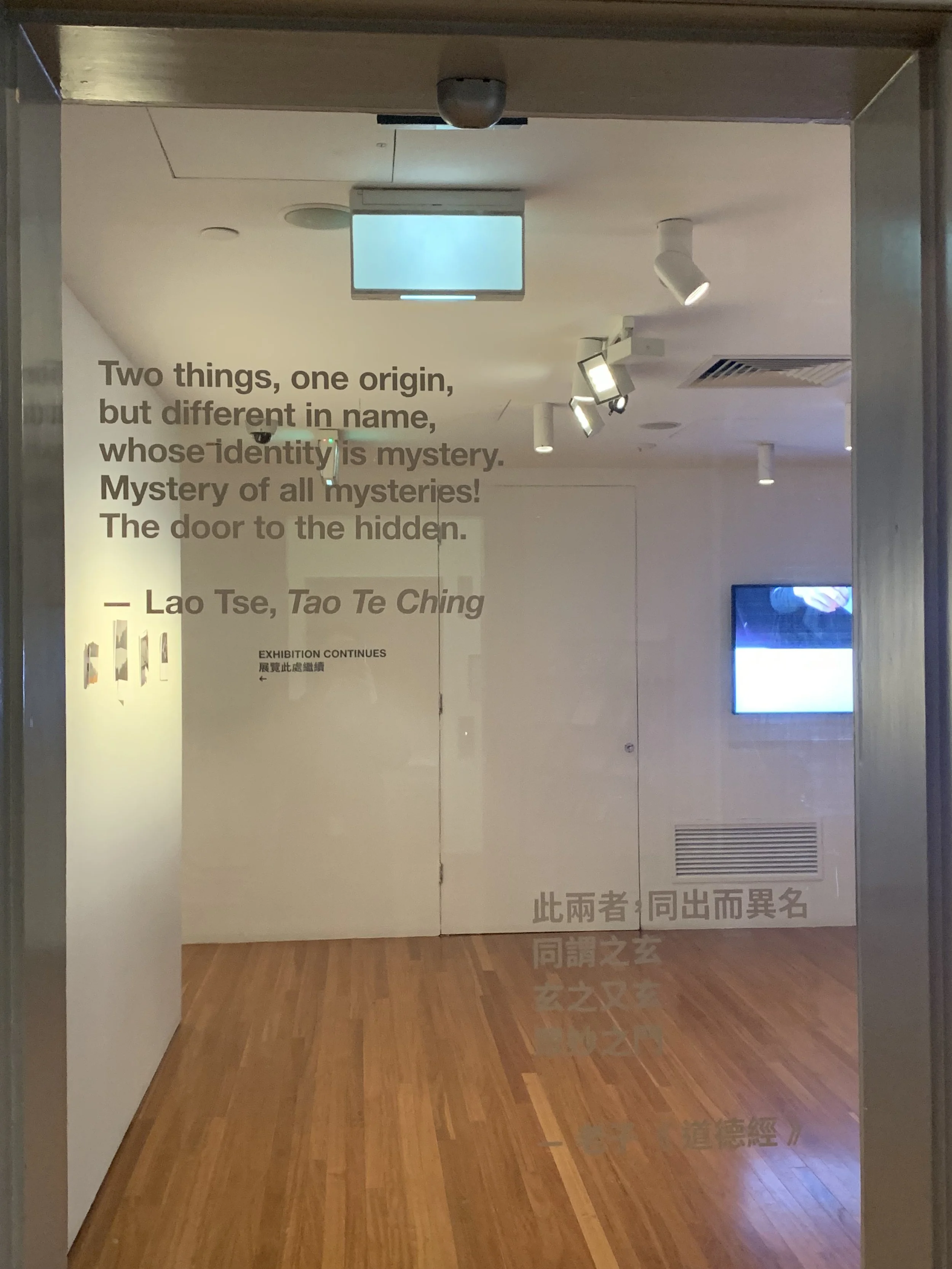Images: Above - Closer Together at RMIT Galleries and below - the launch of Closer Together in Hong Kong with HKAS board members and Australian Consul and Victorian Government representatives, January 5, 2024.
CLOSER TOGETHER (2023 Melbourne & 2024 Hong Kong)
Reflections on the RMIT School of Art and Hong Kong Art School’s 25-year partnership
RMIT Gallery, Melbourne, June 20 - August 14, 2023
Pao Galleries, Hong Kong Arts Centre, Hong Kong January 5 - 28, 2024
Co-curated by Rachel Cheung, Shirky Chan & Tammy Wong Hulbert
Two things, one origin,
but different in name,
whose identity is mystery.
Mystery of all mysteries!
The door to the hidden.
– Lao Tzu
Closer Together reflects upon the intimacy of the cross-cultural relationships developed between the Hong Kong Art School and the RMIT School of Art in Melbourne. As a partnership of over 25 years, it is proudly one of RMIT University’s longest running transnational educational alliances (1). This on-going relationship has enabled everyone involved – staff and students alike – to participate in exchanging knowledge, learning from each other, growing and evolving through an artistic, creative and material lens. As the Chinese classic text the Tao Te Ching suggests, our world is made up of two entities which are ultimately the same: the world that we know and the world that is unknown. When we are together, the mysteries of unknown knowledge can be understood more clearly through dialogue, the creative process and art-making. The experience of gaining knowledge that originally appeared hidden to us is enlightening and can alter the way we perceive the world.
By presenting works from the Hong Kong Art School and RMIT’s expanded community of alumni and academic staff, this exhibition explores various notions of intimacy. While this institutional partnership has graduated hundreds of students over the past 25 years, this exhibition shines a light on the voices of 15 artists from Hong Kong and Melbourne. Closer Together includes the artists Kay Mei Ling Beadman, Movana Chen, Ryan Christopher Cheng, Kris Coad, Carolyn Eskdale, Daphne Alexis Ho, Jaffa Lam Laam, Ivy Ma King Chu, Sally Mannall, Drew Pettifer, Kate Siu Man Kit, Scotty So, Tang Kwong San, Fiona Wong Lai Ching and June Wong Siu Ling.
In the development of Closer Together the co-curators of the exhibition – Rachel Cheung (Hong Kong Art School Lecturer and Program Coordinator) (2) , Shirky Chan (Hong Kong Art School Alumni Lead) (3) and Tammy Wong Hulbert (RMIT Curating and Arts Management academic) (4) – considered what constitutes intimacy and how this may be expressed through action and material form in the art-making process.
The curators examined the ideas of ‘closeness’ and ‘togetherness’ and how intimate relations are formed over time. Not only is intimacy defined as physical closeness; it can also be interpreted as an emotional, chemical or embodied response to the sharing of thoughts, feelings and activities. This kind of togetherness forms a level of closeness that is not limited by distance, time or space – a closeness that can have a long-lasting impact on how we think, act and make creatively in our world. They reflected on the fleeting exchanges that often occur in shared studio environments, especially exchanges that have led to surprising ‘lightbulb’ moments of new artistic insight. These understandings are significant milestones on an artist’s creative journey, often fuelling their curiosity and future investigations.
The RMIT and Hong Kong Art School’s 25-year cross-cultural art-educational relationship was recently challenged and tested by the global pandemic, which imposed new kinds of physical separation, distance and isolation. Coming together virtually despite these difficulties changed the dynamics of the relationship, leaving everyone feeling more connected in spirit and mind and more confident about the strength of the relationship. This renewed confidence and closeness galvanised the desire to highlight the longevity, importance and impact of this shared exchange through an exhibition.
Artists in this exhibition were asked to consider the complexities of being closer and together. They responded in diverse ways, demonstrating their ability to creatively transform ideas and open our eyes to new ways of perceiving and being in the world. While some of the themes explored in the exhibition are universal, others are specific to Hong Kong and Melbourne.
Examining, deconstructing and recreating personal identity through place was explored in several of the works, including those made by Kay Mei Ling Beadman, Movana Chen and Kate Sui Man Kit. Kay Mei Ling Beadman playfully examines the nuances of Hong Kong identity as a legacy of Hong Kong’s colonial past through her work Invisibility Cloaks; she asks us to consider who we are when the personal signifiers of our identity are hidden or obscured, as they are when wearing her oversized cloaks. Movana Chen’s large-scale spectacular Dreconstructing installation presents ways in which the artist has uniquely reconstructed and reinterpreted media into a new context. Chen knits magazines into sculptural forms that reveal how we absorb, re-interpret and recreate the cross-cultural information that is held within their pages. Kate Sui Man Kit learns from the practices of ancient potters; her work Sky . Land . People considers how discarded items collected from the streets of Hong Kong can be reclaimed as materials for her work. By using these materials in her ceramic vessels, she breathes new meaning, context and value into them, imbuing the overlooked with a new significance.
Themes of affinity and social engagement in art are explored by artists Jaffa Lam Laam, June Wong Siu Ling and Scotty So. Jaffa Lam Laam’s practice focuses on social engagements, and for this work she collaborated with a team of seamstresses to reconfigure discarded umbrella fabric into a flag. Hybrid Peace_HK Orchid Tree in Blue makes reference to the flower of the ‘Hong Kong Orchid Tree’, a composite species of plant that was developed from Bauhinia Purpurea and Variegata Blakeana. This plant’s hybridity is used as a metaphor to demonstrate the fusion of Chinese and British cultures, a legacy of Hong’s Kong’s colonial past. Lam pays specific attention to the protective and resilient qualities of umbrella fabric. By bringing this material into relation with the orchid tree, her work symbolises the resilience of Hong Kong’s community. In June Wong Siu Ling’s If there is brilliant sunshine, the artist uses animation to depict the lives of Hong Kong’s prisoners. Her socially engaged practice focuses on experiences of incarceration and the shared conditions of daily life to build compassion and empathy with the broader community. Influenced in-part by RMIT and the Hong Kong Art School’s educational partnership, Scotty So immigrated from Hong Kong to Melbourne. So’s work in the exhibition, The Dance of the Seven Scarlett Veils, is a drag performance and a part of his ongoing exploration of gender and sexuality. This diptych video documents two strip-tease performances by the artist dressed in cheung sam (a traditional form-fitting Chinese dress), subverting traditional notions of femininity and reflecting on the social and cultural construction of gender identity.
Notions of stillness, silence and closeness are explored by artists Kris Coad, Daphne Alexis Ho, Ivy Ma King Chu, Tang Kwong San and Fiona Wong Lai Ching. Kris Coad’s shelter… recreates an empty dining-room setting to reflectively contemplate the physical absence of a community. The work combines Coad’s ceramics practice of functional tableware with her larger light-based installations. Daphne Alexis Ho’s work considers the landscape of Hong Kong Island in a time of anxiety prompted by the global pandemic. Using lens of Zen aesthetics, Ho finds beauty at a distance. The artist also noted that the quiet and contemplative process of photography during this period of disruption was therapeutic, having a stabilising effect. Meanwhile, artist and traveller Ivy Ma King Chu finds inspiration in birds, whose movements convey a spirit of freeness and are not confined by geopolitical borders. Through his drawn interpretations of personal and collective archive items, Tang Kwong San sensitively reflects upon his migration from China to Hong Kong. And Fiona Wong Lai Ching honours her home city by capturing in the permanence of ceramic a delicate glorious moment of the Hong Kong sky.
The works of Carolyn Eskdale and Ryan Christopher Cheng demonstrate that the concept of closeness can also be expressed non-verbally. Carolyn Eskdale’s dialogue room pressing reveals how acts of presence, touch and collaborative making can create intimacy. dialogue column pressing 06.23 furthers this, showing how we can relate and experience closeness and connection to both people and place through the act of touch. Ryan Christopher Cheng’s wheel-thrown series Family demonstrates his passion for exploring forms that push the medium of clay to its limit. Each vessel is similar to one another but also strikingly individual, a metaphor for how we each function in our personal family lives.
Finally, closeness and personal stories are expressed through intimate relationships by the artists Sally Mannall and Drew Pettifer. In A Garden of Stories, Sally Mannall focuses on the domestic garden as a site of generosity and exchange and examines its role and significance in everyday life. Each of the stories she presents reflects on how plants in a garden have played a meaningful role in interpersonal relationships. Drew Pettifer captures closeness through the intimate portraits of his male subjects. The series Some want quietly was produced during his residency in Japan. It reflects on Pettifer’s own position as a queer Australian man by examining different societal and cultural codes of masculinity and gender.
Closer Together portrays intimate moments of vulnerability and also reminds us that we are ultimately stronger when brought together as a community. This exhibition is a space to honour the intimacy and trust of our relationships and to celebrate our sense of community, kinship and connectivity. Through the eyes of artists, Closer Together provides a path to the hidden and offers us the glimpse of a future which is both hopeful and optimistic.
Shirky Chan, Rachel Cheung and Tammy Wong Hulbert
Co-curators
(This essay was written for the exhibition)
1. Le Guin, U (ed.) (1997) Lao Tzu, Tao Te Ching: A Book about the Way and the Power of the Way, Shambhala, Boston, p. 15.
2. The curators would also like to acknowledge the Rhett D’Costa, former RMIT Hong Kong Program Manager, who was involved in the early stages of this exhibition’s curation.




